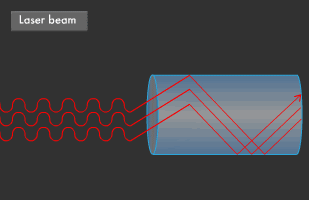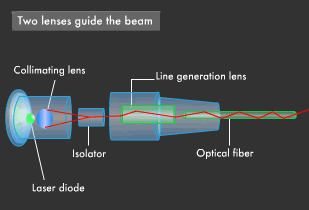Canon Science Lab
Optical Fibers
Optical fibers are highly pure glass fibers of about 120 μm in diameter - the width of three human hairs-that can carry optical signals reliably over vast distances.
Optical fibers transmit data in the form of light or optical signals. They are made of highly pure glass, so free of impurities that they can transmit 95.5% of a light signal over a distance of one kilometer. This means that, theoretically, one would still be able to clearly view the scenery outside through a kilometer-thick window made of such glass. When you consider that about half of any light passing through a window a few centimeters thick made of ordinary glass would be blocked, then you can appreciate just how transparent the glass used in optical fibers is. It is this very high transparency that enables optical fibers to transmit optical signals over long distances without attenuation.
Trapping Light in a Core
Optical fibers are composed of a central core, and a surrounding layer known as the cladding. The core is provided with a high refractive index, while a lower refractive index is used for the cladding. This difference in refractive indices is incorporated to ensure smooth travel of light along the core. Light travels across the boundary between mediums with the same refractive index, but from a medium with a high refractive index to a medium with a low refractive index, light is totally reflected when the incident angle becomes rather large.

Optical signals travel along the cores of optical fibers. Optical fibers are made in such a way that optical signals undergo total internal reflection at the boundary between the core and the cladding, owing to the difference in the refractive indices of the two media. This principle of total internal reflection is used to trap optical signals within the core.
Lasers: the Best Light for Optical Fiber Communications
Laser light is used for optical fiber communications for the simple reason that it is a single wavelength light source. Sunlight or the light emitted by a light bulb is a mixture of many different wavelengths of light. Because the light waves of such light are all out of phase with one another, they do not produce a very powerful beam. Laser beams, however, have a single wavelength, and so their waves are all in phase, producing very powerful light.

The speed of light traveling along an optical fiber changes in accordance with its wavelength. Because ordinary light contains many different wavelengths of light, differences emerge in speed of transmission, reducing the number of signals that can be transmitted in any set time. Being a single wavelength light source with uniform phase, laser light travels smoothly with very little dispersion, making it ideal for long distance communications.
Single Mode and Multimode
Optical fibers can be divided broadly into two types according to the way in which they transmit optical signals. One type, known as single-mode fiber, has a thin core with a diameter of about 10 μm ( 1 μm = one millionth of a meter ), and allows light pulses to propagate in only one mode. The other type, multimode fiber, has a thick core of about 50 μm in diameter, and permits the propagation of multiple light pulses of differing angles of reflection.

However, in multimode fiber the distance at which signals can propagate differs according to the angle of reflection, resulting in disparities in the arrival time of signals. As such, multimode fibers are used mainly for low- and medium-capacity transmission over relatively short distances. Most optical fiber in use today is single-mode fiber that enables high speed, high capacity transmission.
Sending Light by Optical Fiber
Optical fibers have cores with diameters ranging from 10 to 50 μm. Optical signals are fed into the cores of these fibers using devices known as LD (laser diode) modules. Laser light generated by a high-output laser diode is passed through the lenses of the LD module to be fed into the fiber core. Two types of lens-an elliptical collimating lens and a rod-shaped line generation lens-are used to focus the laser beam and direct it towards the optical fiber core.

